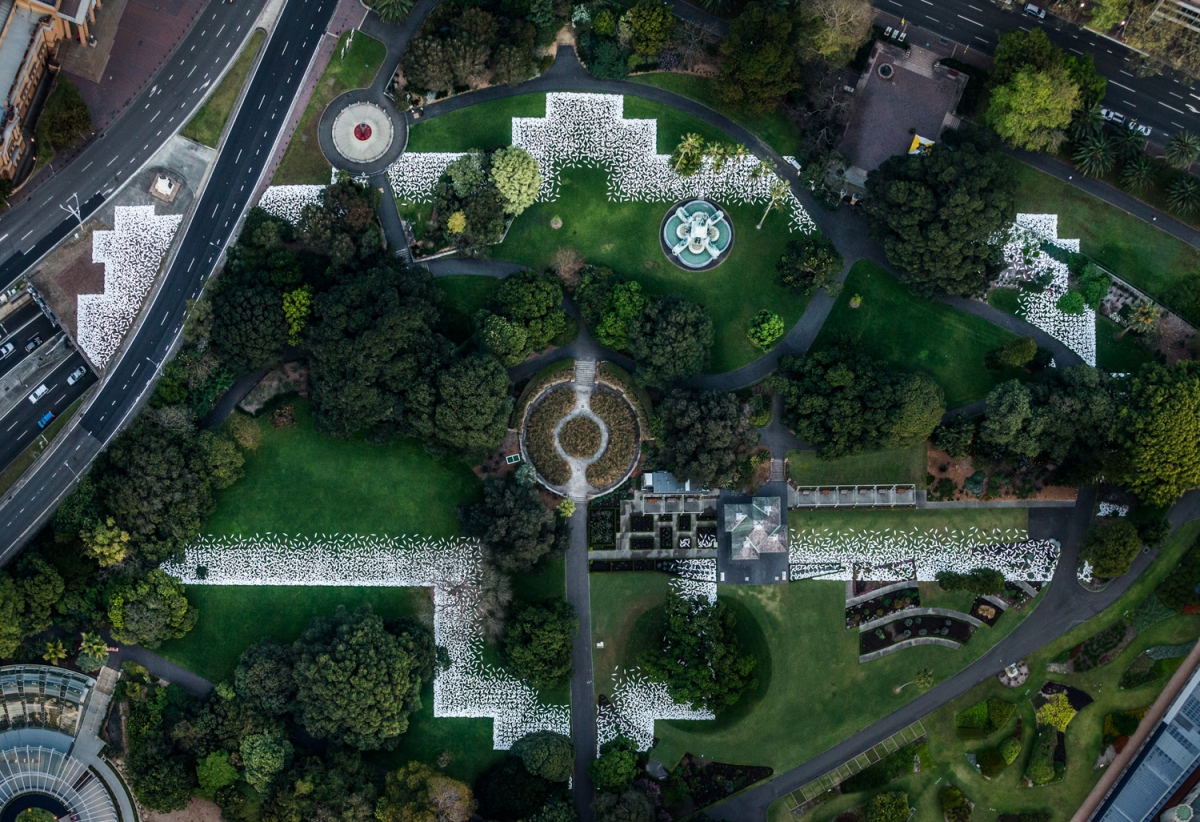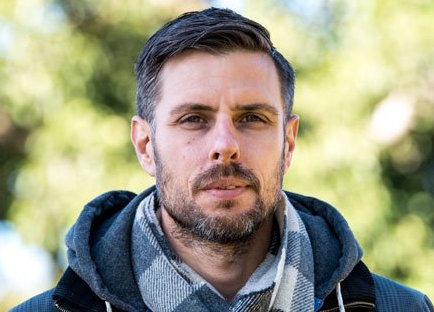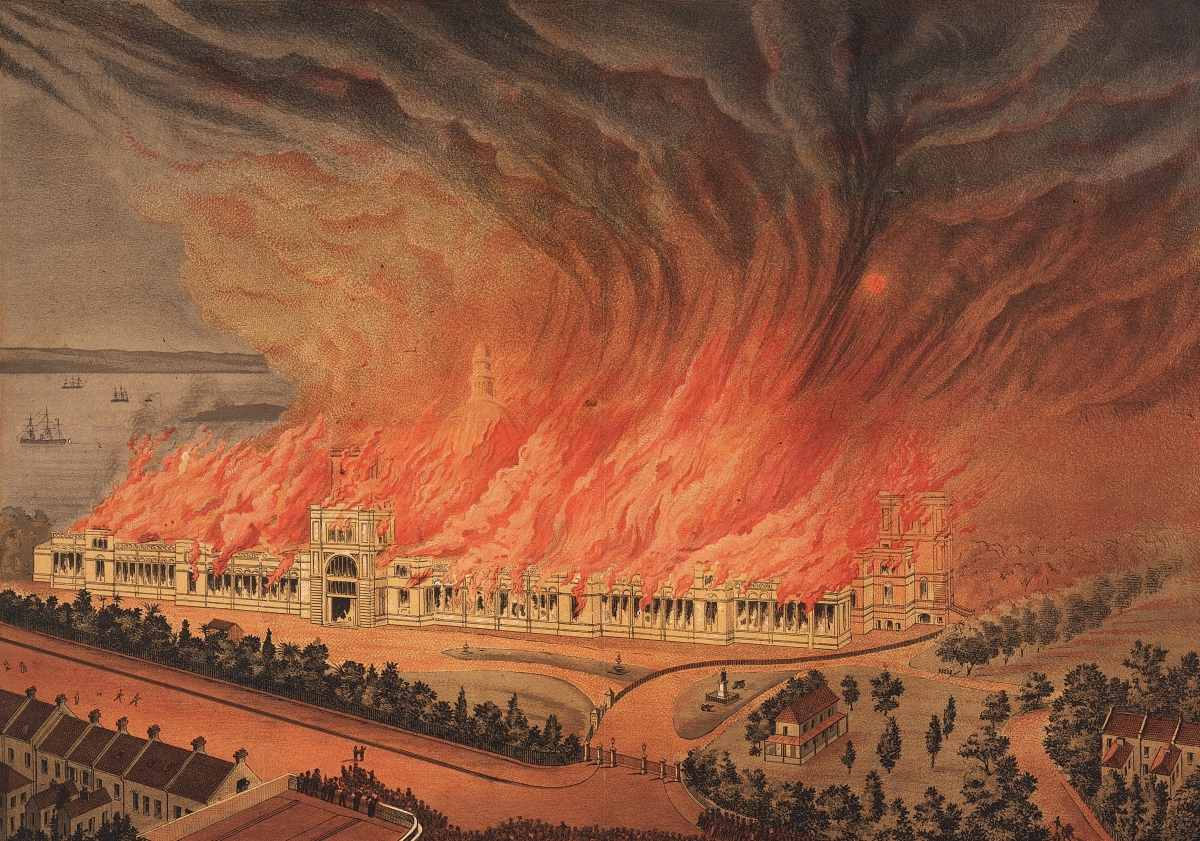The Australian artist explores Sydney’s forgotten history in his 32nd Kaldor Public Art Project barrangal dyara (skin and bones).
Few realise that Sydney’s Royal Botanic Garden was once the site of the Garden Palace – a structure larger than the Queen Victoria Building and topped by the sixth largest dome in the world – that stood above the harbour for three years before it burned to the ground. The Palace, a prominent symbol of nation-building, had been used to house a large number of Aboriginal objects collected along the colonial frontier, almost all of which were lost in the blaze.
Now Wiradjuri/Kamilaroi artist Jonathan Jones’ barrangal dyara (skin and bones) – the first Kaldor Public Art Project produced with an Aboriginal Artist – seeks to reawaken lost memories, tracing the footprint of the Garden Palace’s remains with 15,000 bleached white shields. The name comes from the local Sydney language, barrangal meaning skin and darya meaning bones.
 Jonathan Jones’ barrangal dyara (skin and bones), photo © Peter Greig
Jonathan Jones’ barrangal dyara (skin and bones), photo © Peter Greig
“Barrangal dyara is a response to the immense loss felt throughout Australia due to the destruction of countless culturally significant Aboriginal objects when the Palace was razed by fire on 22 September 1882,” said Jones. “It represents an effort to commence a healing process and a celebration of the survival of the world’s oldest living culture despite this traumatic event.”
The white shields strewn across the gardens are based on four typical designs from Aboriginal nations of the south-east. “Really we were mapping out the regions,” said Jones, speaking at a media preview for the exhibition. “Those shield designs are a really important part of identifying country and where people are from.”
Aerial footage of barrangal darya (skin and bones)
Walking through the gardens, visitors will also hear voices – sound installations documenting the revival of Aboriginal languages. “There’s an extraordinary language revival movement, where Aboriginal communities right across the south-east are learning language again, often for the first time in many generations,” said Jones. “What we were keen to do was use language as a way of awakening this lost knowledge, and I guess what language has reminded us is that nothing’s lost. Sometimes some of these communities have not spoken their language for generations and yet people are picking up this knowledge again, they’re learning this knowledge again and they’re bringing it back to their families.”
One of the sound installations features the voices of kindergarten children reciting lists of objects in the Kamilaroi language. “This little soundscape reminds us – all these soundscapes remind us – that nothing is lost,” said Jones. “I think it’s the most amazing thing when you hear little ones starting to learn language for the first time. And they go home and speak to their grandparents in their language.”
 Jonathan Jones, photo © Zan Wimberley
Jonathan Jones, photo © Zan Wimberley
At the very heart of barrangal dyara, the circular garden that commemorates where the Palace’s dome once stood has been filled with Kangaroo Grass. The grass, a staple of Aboriginal agriculture in the south-east of Australia, thrives on regular burning and serves as a metaphor for rebirth but also a reminder that, following the discovery of a 30,000-year-old grinding stone, Aboriginal Australians are now considered the first bread-making people on Earth, predating the Egyptians by 15,000 years.
Visitors to the Botanic Gardens will be able to add another layer to their experience of the artwork by downloading the free Project 32 app, which activates as visitors walk through the gardens, allowing them to hear insights from cultural leaders, historians, theorists, artists, writers and cultural practitioners discussing the ideas explored by barrangal dyara (skin and bones).
 Garden Palace Fire 1882, lithograph from Illustrated Sydney News Supplement, Powerhouse Museum Collection, P2239
Garden Palace Fire 1882, lithograph from Illustrated Sydney News Supplement, Powerhouse Museum Collection, P2239
September 22 marks the anniversary of the fire that destroyed the Garden Palace, and an evening of special events will be held, including performances by Bangarra Dance Theatre, the Gondwana Choirs, a language presentation by Wiradjuri students from Parkes, Stories with Aunty Julie Freeman (a Gorawarl Jerrawongarla woman) and the launch of the barrangal dyara (skin and bones) catalogue with author David Malouf. While Jones has focused on story-telling as a means of remembrance in his artwork, the catalogue will feature over 100 historical and contemporary illustrations.
For Jones, this project is not so much about mourning the destruction of Aboriginal objects as it is about celebrating the resilience and survival of cultures that have existed for thousands of years. “Our 32nd project created by Jonathan Jones is one of our most significant and ambitious to date. My admiration for Jonathan has grown as the project has progressed, and his great knowledge and compassion has given me an insight into a different Australia,” said John Kaldor, founder of Kaldor Public Art Projects. “It re-tells the imperative local history from an Aboriginal perspective, giving new light to the Garden Palace’s history, whilst also speaking to cultural tensions still present in contemporary Australia.”
The 32nd Kaldor Public Art Project, Jonathan Jones’ barrangal dyara (skin and bones) is at the Royal Botanic Garden September 17 to October 3. For more information, or to download the Project 32 App, visit kaldor.org











Comments
Log in to join the conversation.